Page 61 of 558

ENGINE – Water Pump and Water Hose11-36
INSTALLATION SERVICE POINTS
�A�WATER PIPE / O-RING INSTALLATION
Wet the O-ring (with water) to facilitate assembly.
Caution
Keep the O-ring free of oil or grease.
�B�THERMOSTAT HOUSING INSTALLATION
Apply 3 mm diameter of form-in-place gasket (FIPG) to the
location shown in the illustration.
Specified sealant:
Mitsubishi Genuine Part No. MD970389 or equivalent
�C�WATER OUTLET FITTING INSTALLATION
Apply 3 mm diameter of form-in-place gasket (FIPG) to the
location shown in the illustration.
Specified sealant:
Mitsubishi Genuine Part No. MD970389 or equivalent
�D�SEALANT APPLICATION TO ENGINE COOLANT
TEMPERATURE GAUGE UNIT
(1) When reusing the gauge unit, clean its thread.
(2) Apply the specified sealant to the thread.
Specified sealant:
3M
TM AAD Part No. 8672 or equivalent
�E�SEALANT APPLICATION TO ENGINE COOLANT
TEMPERATURE SENSOR
(1) When reusing the sensor, clean its thread.
(2) Apply the specified sealant to the thread.
Specified sealant:
3M
TM AAD Part No. 8731 or equivalent
6EN0594
Water pipe
O-ring
9EN0092
9EN0091
Page 63 of 558
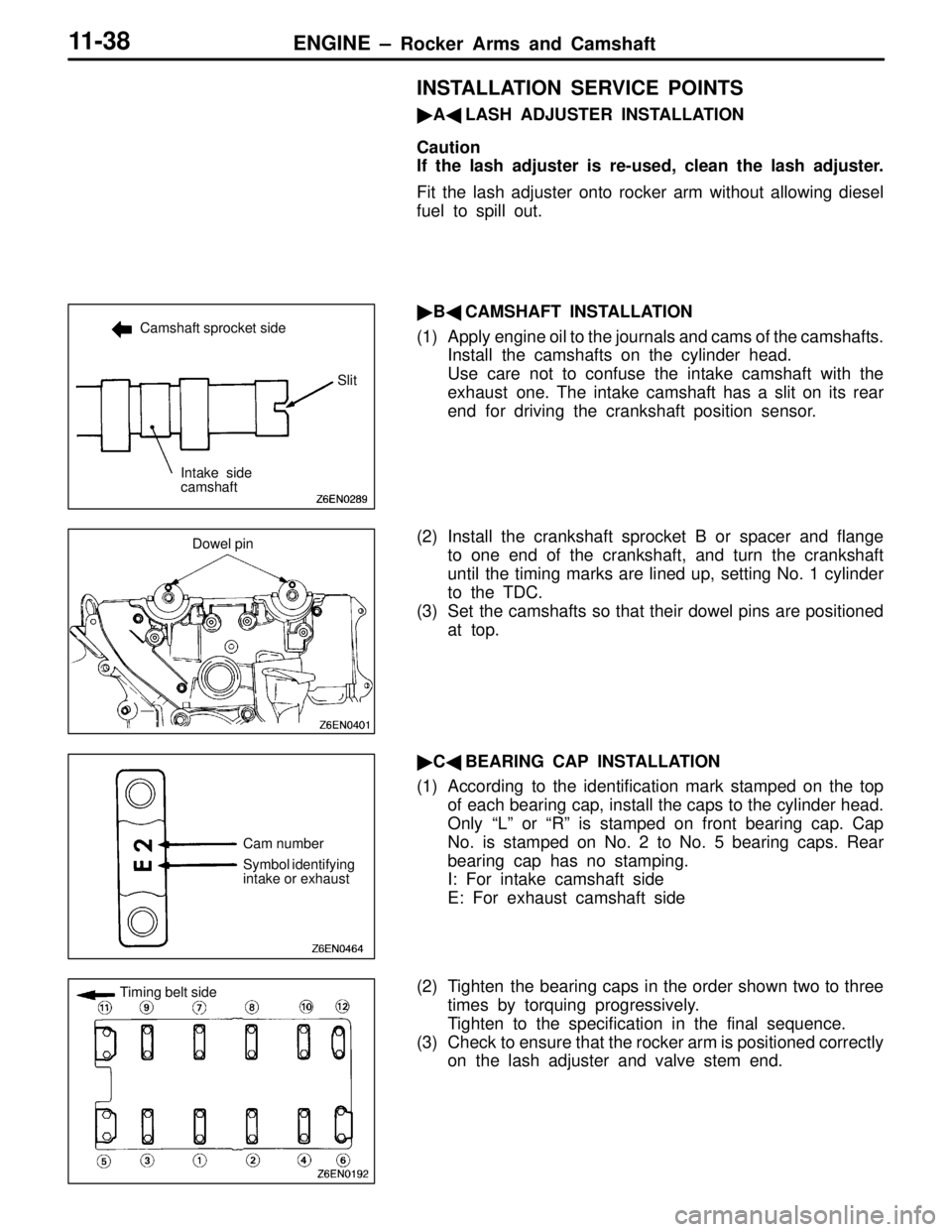
ENGINE – Rocker Arms and Camshaft11-38
INSTALLATION SERVICE POINTS
�A�LASH ADJUSTER INSTALLATION
Caution
If the lash adjuster is re-used, clean the lash adjuster.
Fit the lash adjuster onto rocker arm without allowing diesel
fuel to spill out.
�B�CAMSHAFT INSTALLATION
(1) Apply engine oil to the journals and cams of the camshafts.
Install the camshafts on the cylinder head.
Use care not to confuse the intake camshaft with the
exhaust one. The intake camshaft has a slit on its rear
end for driving the crankshaft position sensor.
(2) Install the crankshaft sprocket B or spacer and flange
to one end of the crankshaft, and turn the crankshaft
until the timing marks are lined up, setting No. 1 cylinder
to the TDC.
(3) Set the camshafts so that their dowel pins are positioned
at top.
�C�BEARING CAP INSTALLATION
(1) According to the identification mark stamped on the top
of each bearing cap, install the caps to the cylinder head.
Only “L” or “R” is stamped on front bearing cap. Cap
No. is stamped on No. 2 to No. 5 bearing caps. Rear
bearing cap has no stamping.
I: For intake camshaft side
E: For exhaust camshaft side
(2) Tighten the bearing caps in the order shown two to three
times by torquing progressively.
Tighten to the specification in the final sequence.
(3) Check to ensure that the rocker arm is positioned correctly
on the lash adjuster and valve stem end.
Camshaft sprocket side
Slit
Intake side
camshaft
Dowel pin
Cam number
Symbol identifying
intake or exhaust
Timing belt side
Page 69 of 558
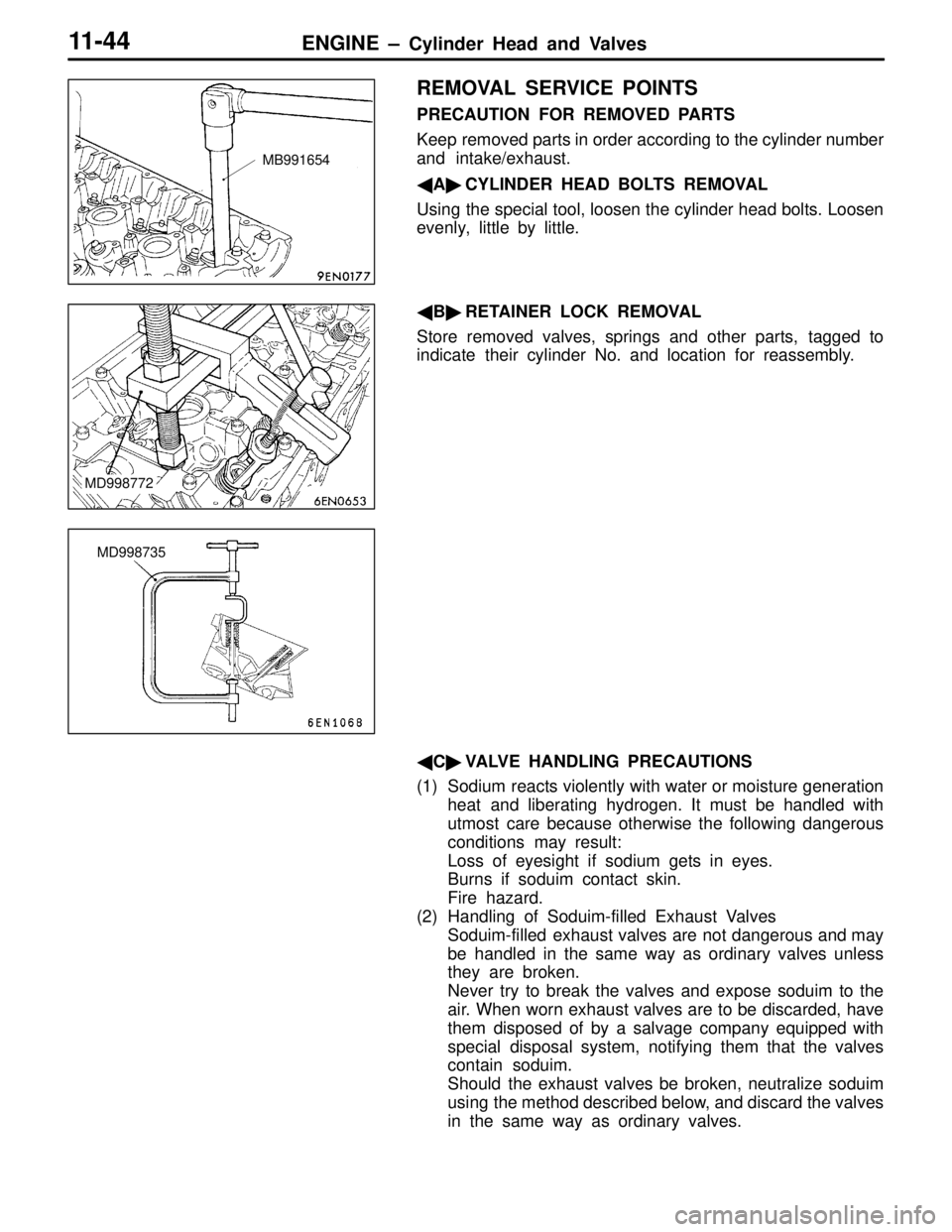
ENGINE – Cylinder Head and Valves11-44
REMOVAL SERVICE POINTS
PRECAUTION FOR REMOVED PARTS
Keep removed parts in order according to the cylinder number
and intake/exhaust.
�A�CYLINDER HEAD BOLTS REMOVAL
Using the special tool, loosen the cylinder head bolts. Loosen
evenly, little by little.
�B�RETAINER LOCK REMOVAL
Store removed valves, springs and other parts, tagged to
indicate their cylinder No. and location for reassembly.
�C�VALVE HANDLING PRECAUTIONS
(1) Sodium reacts violently with water or moisture generation
heat and liberating hydrogen. It must be handled with
utmost care because otherwise the following dangerous
conditions may result:
Loss of eyesight if sodium gets in eyes.
Burns if soduim contact skin.
Fire hazard.
(2) Handling of Soduim-filled Exhaust Valves
Soduim-filled exhaust valves are not dangerous and may
be handled in the same way as ordinary valves unless
they are broken.
Never try to break the valves and expose soduim to the
air. When worn exhaust valves are to be discarded, have
them disposed of by a salvage company equipped with
special disposal system, notifying them that the valves
contain soduim.
Should the exhaust valves be broken, neutralize soduim
using the method described below, and discard the valves
in the same way as ordinary valves.
MB991654
MD998772
MD998735
Page 70 of 558
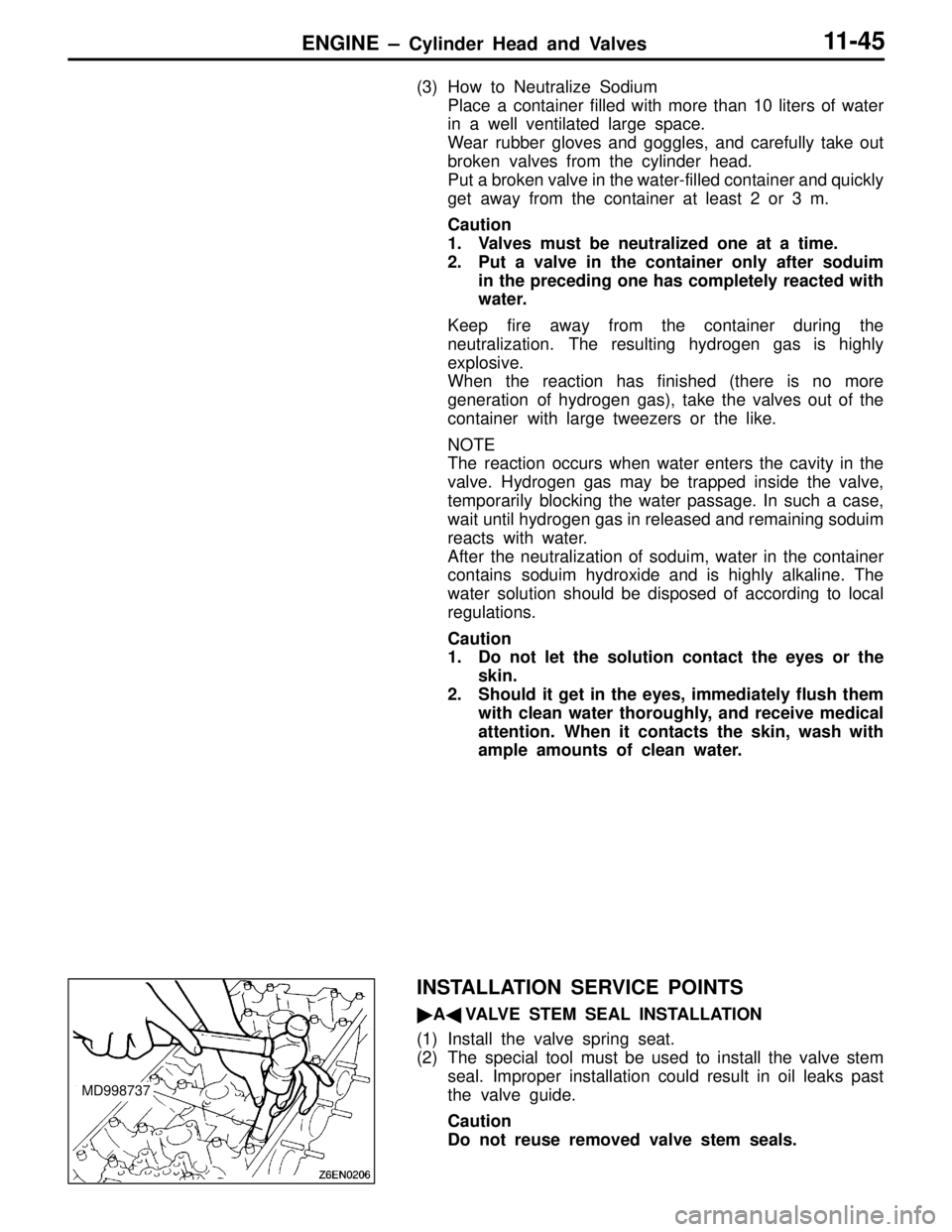
ENGINE – Cylinder Head and Valves11-45
(3) How to Neutralize Sodium
Place a container filled with more than 10 liters of water
in a well ventilated large space.
Wear rubber gloves and goggles, and carefully take out
broken valves from the cylinder head.
Put a broken valve in the water-filled container and quickly
get away from the container at least 2 or 3 m.
Caution
1. Valves must be neutralized one at a time.
2. Put a valve in the container only after soduim
in the preceding one has completely reacted with
water.
Keep fire away from the container during the
neutralization. The resulting hydrogen gas is highly
explosive.
When the reaction has finished (there is no more
generation of hydrogen gas), take the valves out of the
container with large tweezers or the like.
NOTE
The reaction occurs when water enters the cavity in the
valve. Hydrogen gas may be trapped inside the valve,
temporarily blocking the water passage. In such a case,
wait until hydrogen gas in released and remaining soduim
reacts with water.
After the neutralization of soduim, water in the container
contains soduim hydroxide and is highly alkaline. The
water solution should be disposed of according to local
regulations.
Caution
1. Do not let the solution contact the eyes or the
skin.
2. Should it get in the eyes, immediately flush them
with clean water thoroughly, and receive medical
attention. When it contacts the skin, wash with
ample amounts of clean water.
INSTALLATION SERVICE POINTS
�A�VALVE STEM SEAL INSTALLATION
(1) Install the valve spring seat.
(2) The special tool must be used to install the valve stem
seal. Improper installation could result in oil leaks past
the valve guide.
Caution
Do not reuse removed valve stem seals.
MD998737
Page 72 of 558
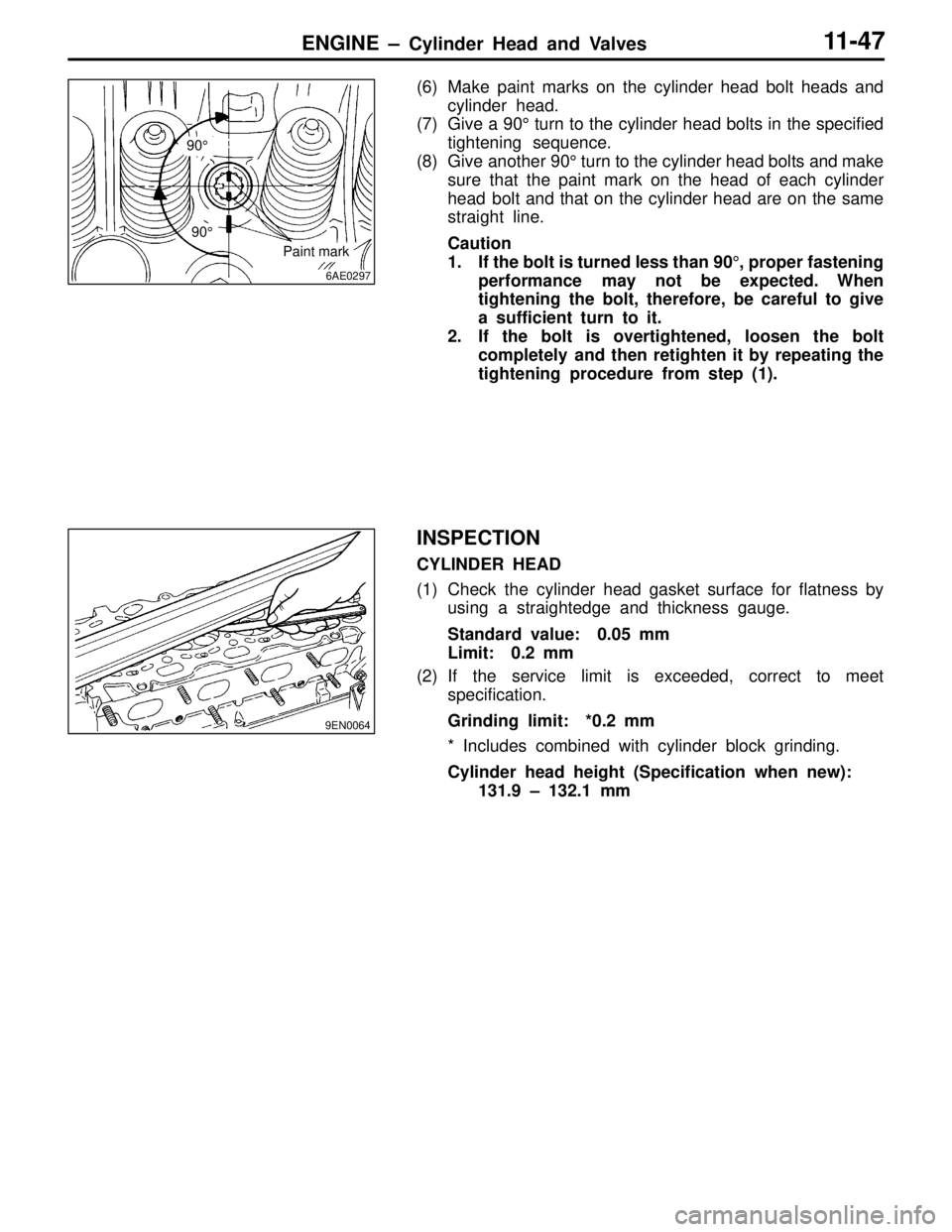
ENGINE – Cylinder Head and Valves11-47
(6) Make paint marks on the cylinder head bolt heads and
cylinder head.
(7) Give a 90° turn to the cylinder head bolts in the specified
tightening sequence.
(8) Give another 90° turn to the cylinder head bolts and make
sure that the paint mark on the head of each cylinder
head bolt and that on the cylinder head are on the same
straight line.
Caution
1. If the bolt is turned less than 90°, proper fastening
performance may not be expected. When
tightening the bolt, therefore, be careful to give
a sufficient turn to it.
2. If the bolt is overtightened, loosen the bolt
completely and then retighten it by repeating the
tightening procedure from step (1).
INSPECTION
CYLINDER HEAD
(1) Check the cylinder head gasket surface for flatness by
using a straightedge and thickness gauge.
Standard value: 0.05 mm
Limit: 0.2 mm
(2) If the service limit is exceeded, correct to meet
specification.
Grinding limit: *0.2 mm
* Includes combined with cylinder block grinding.
Cylinder head height (Specification when new):
131.9 – 132.1 mm
6AE0297
90°
Paint mark
90°
9EN0064
Page 73 of 558
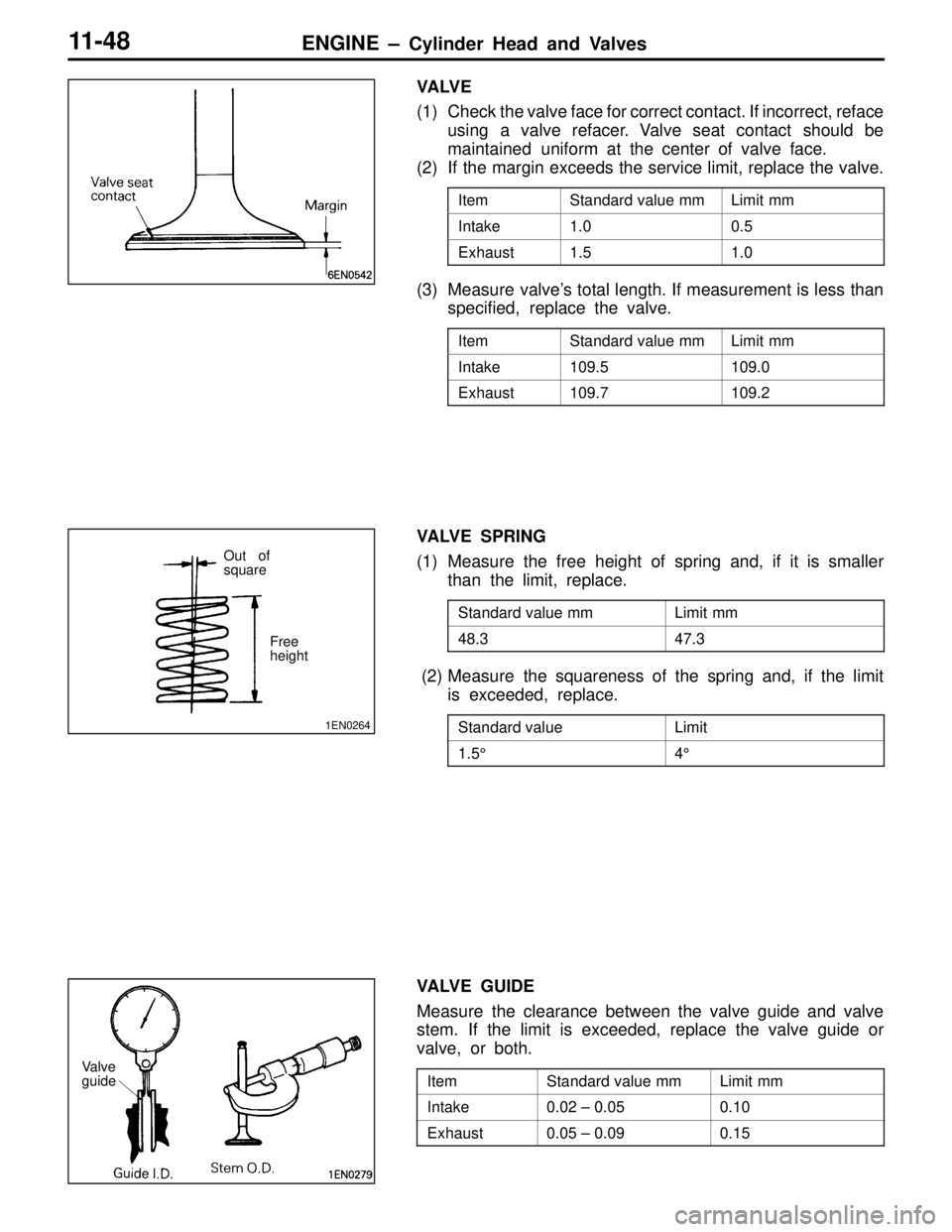
ENGINE – Cylinder Head and Valves11-48
VA LV E
(1) Check the valve face for correct contact. If incorrect, reface
using a valve refacer. Valve seat contact should be
maintained uniform at the center of valve face.
(2) If the margin exceeds the service limit, replace the valve.
ItemStandard value mmLimit mm
Intake1.00.5
Exhaust1.51.0
(3) Measure valve’s total length. If measurement is less than
specified, replace the valve.
ItemStandard value mmLimit mm
Intake109.5109.0
Exhaust109.7109.2
VALVE SPRING
(1) Measure the free height of spring and, if it is smaller
than the limit, replace.
Standard value mmLimit mm
48.347.3
(2) Measure the squareness of the spring and, if the limit
is exceeded, replace.
Standard valueLimit
1.5°4°
VALVE GUIDE
Measure the clearance between the valve guide and valve
stem. If the limit is exceeded, replace the valve guide or
valve, or both.
ItemStandard value mmLimit mm
Intake0.02 – 0.050.10
Exhaust0.05 – 0.090.15
1EN0264
Free
height
Out of
square
Valve
guide
Page 77 of 558
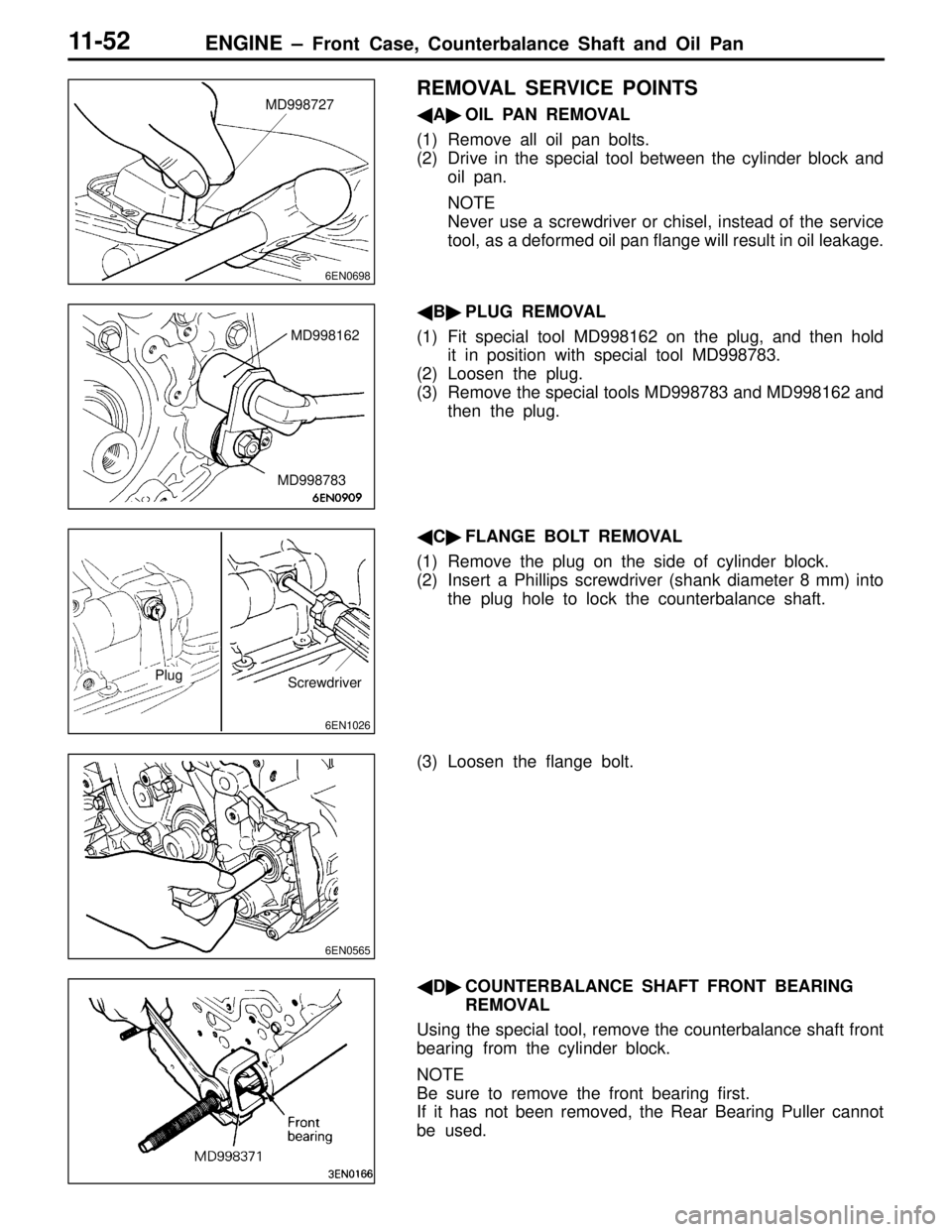
ENGINE – Front Case, Counterbalance Shaft and Oil Pan11-52
REMOVAL SERVICE POINTS
�A�OIL PAN REMOVAL
(1) Remove all oil pan bolts.
(2) Drive in the special tool between the cylinder block and
oil pan.
NOTE
Never use a screwdriver or chisel, instead of the service
tool, as a deformed oil pan flange will result in oil leakage.
�B�PLUG REMOVAL
(1) Fit special tool MD998162 on the plug, and then hold
it in position with special tool MD998783.
(2) Loosen the plug.
(3) Remove the special tools MD998783 and MD998162 and
then the plug.
�C�FLANGE BOLT REMOVAL
(1) Remove the plug on the side of cylinder block.
(2) Insert a Phillips screwdriver (shank diameter 8 mm) into
the plug hole to lock the counterbalance shaft.
(3) Loosen the flange bolt.
�D�COUNTERBALANCE SHAFT FRONT BEARING
REMOVAL
Using the special tool, remove the counterbalance shaft front
bearing from the cylinder block.
NOTE
Be sure to remove the front bearing first.
If it has not been removed, the Rear Bearing Puller cannot
be used.
6EN0698
MD998727
MD998162
MD998783
6EN1026
Plug
Screwdriver
6EN0565
Page 78 of 558

ENGINE – Front Case, Counterbalance Shaft and Oil Pan11-53
�E�COUNTERBALANCE SHAFT REAR BEARING
REMOVAL
Using the special tool, remove the left counterbalance shaft
rear bearing from the cylinder block.
NOTE
When removing the left counterbalance shaft rear bearing,
install the special tool (MB991603) in front of the cylinder
block.
INSTALLATION SERVICE POINTS
�A�RIGHT COUNTERBALANCE SHAFT REAR
BEARING INSTALLATION
(1) Apply engine oil to the outer surface of bearing.
(2) Using special tools, install right rear bearing. Make sure
that oil hole of bearing is aligned with oil hole of cylinder
block.
�B�LEFT COUNTERBALANCE SHAFT REAR
BEARING INSTALLATION
(1) Install the special tool (Guide Plate) to the cylinder block.
(2) Apply engine oil to the rear bearing outer circumference
and bearing hole in the cylinder block.
(3) Using the special tool, install the rear bearing.
NOTE
The left rear bearing has no oil holes.
MB991603
6EN1034
MD998705
MB991603
6EN0557
MB991603Rear bearing
MD998705